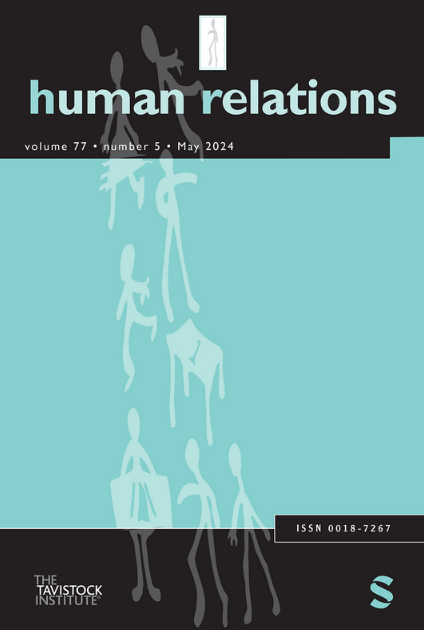变形:边界物体如何影响视觉、语言和具身模式的意义生成
IF 5.4
2区 管理学
Q1 MANAGEMENT
引用次数: 0
摘要
边界对象帮助合作者创造共同的意义,协调他们跨越差异的工作。认识到这种过程的复杂动态性,我们提出了一个多模式的替代方案,以取代传统研究中对边界对象的静态看法,并提出以下问题:边界对象是如何 "变形 "的?它们是如何以不同的形式出现在视觉、语言和体现模式中的?采用 "强 "多模态视角,我们展示了边界对象是如何随着协作工作的进行,通过跨模态和在模态内的形状变化而扩展形式的。我们还展示了它们如何随着时间的推移而收缩,只以某些形状而非其他形状重新出现,而且往往是以简化的形式出现。这些动态变化既促进了意义的生成,也限制了意义的生成。边界对象不断扩展的形状可以让合作者形成丰富的共同理解。反过来,收缩的形状又将意义生成浓缩为熟悉对象的人之间的高效交流,而对于无法理解收缩形状的新来者来说,意义生成则变得模糊不清。我们的研究为边界对象的多模态性质提供了新的视角,并展示了对象形状的变化是如何影响意义生成的。更广泛地说,我们以丰富的经验说明了各种模式是如何在实践中纠缠在一起的,揭示了它们的过程性和不可分割性。本文章由计算机程序翻译,如有差异,请以英文原文为准。
Shape-shifting: How boundary objects affect meaning-making across visual, verbal, and embodied modes
Boundary objects help collaborators create shared meaning and coordinate their work across differences. Acknowledging the complex dynamics of such processes, we propose a multimodal alternative to studies’ traditionally static view of boundary objects and ask: How do boundary objects “shape-shift”? How do they emerge in varying forms across visual, verbal, and embodied modes, and in what ways does this “shape-shifting” affect meaning-making? Adopting a “strong” multimodal lens, we show how boundary objects expand in form as collaborative work proceeds through shifting shapes both across and within modes. We also show how they contract over time, reemerging exclusively in some and not other shapes, often in simplified forms. These dynamics both enable and constrain meaning-making. Expanding shapes of the boundary object allow collaborators to develop rich shared understandings. Contracting shapes, in turn, condense meaning-making into efficient communication among those familiarized with the object, yet obscure meaning-making for newcomers who cannot make sense of its contracted shapes. Our study sheds new light on boundary objects’ multimodal nature and demonstrates how objects’ shifting shapes affect meaning-making. More generally, we offer a rich empirical account of how modes enmesh in practice, unveiling their processual and inseparable complexion.
求助全文
通过发布文献求助,成功后即可免费获取论文全文。
去求助
来源期刊

Human Relations
Multiple-
CiteScore
12.60
自引率
7.00%
发文量
82
期刊介绍:
Human Relations is an international peer reviewed journal, which publishes the highest quality original research to advance our understanding of social relationships at and around work through theoretical development and empirical investigation. Scope Human Relations seeks high quality research papers that extend our knowledge of social relationships at work and organizational forms, practices and processes that affect the nature, structure and conditions of work and work organizations. Human Relations welcomes manuscripts that seek to cross disciplinary boundaries in order to develop new perspectives and insights into social relationships and relationships between people and organizations. Human Relations encourages strong empirical contributions that develop and extend theory as well as more conceptual papers that integrate, critique and expand existing theory. Human Relations welcomes critical reviews and essays: - Critical reviews advance a field through new theory, new methods, a novel synthesis of extant evidence, or a combination of two or three of these elements. Reviews that identify new research questions and that make links between management and organizations and the wider social sciences are particularly welcome. Surveys or overviews of a field are unlikely to meet these criteria. - Critical essays address contemporary scholarly issues and debates within the journal''s scope. They are more controversial than conventional papers or reviews, and can be shorter. They argue a point of view, but must meet standards of academic rigour. Anyone with an idea for a critical essay is particularly encouraged to discuss it at an early stage with the Editor-in-Chief. Human Relations encourages research that relates social theory to social practice and translates knowledge about human relations into prospects for social action and policy-making that aims to improve working lives.
 求助内容:
求助内容: 应助结果提醒方式:
应助结果提醒方式:


